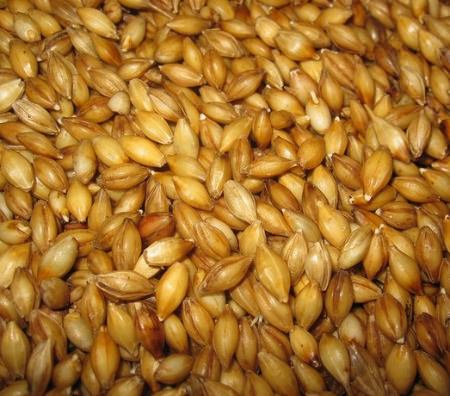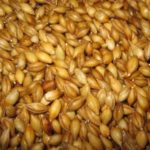 The video lesson plus written recipe features how to make sprouted grains at home and thus make your homemade sprouted flour for all your baking needs.
The video lesson plus written recipe features how to make sprouted grains at home and thus make your homemade sprouted flour for all your baking needs.
China is credited with developing the method for germinating seeds many centuries ago and on long ocean voyages, Chinese sailors used sprouted mung beans as a source of vitamin C for preventing scurvy.
Vitamin C is produced in significant quantities when you sprout seeds. It is absent from unsprouted seeds! Many other nutrients are increased substantially from sprouting grains, as I go over in the videos.
Sprouting Grain
Sprouted flour made from freshly ground sprouted grain is one of the 3 ways traditional societies used to prepare their grains before eating.
This careful preparation of wheat and other grains is necessary in order to break down the antinutrients, toxins, and difficult to digest proteins (i.e., gluten) so as to optimize digestibility and to allow maximum absorption of nutrients.
Unfortunately, this careful preparation method has been lost with our modern cooking methods which focus on speed and convenience rather than nutrient density and digestibility!
Equipment Needed to Sprout Grain
The first item you need to sprout is a half gallon size glass container with a screen lid (like this one). Many health food stores sell sprouting jars, but you can easily make one yourself at home using a glass jar and a clean pair of pantyhose cut to fit the lid of the jar and fastened with a rubber band.
Once you have your jar ready, fill it no more than halfway with the grain you wish to sprout. I use organic spelt or organic soft white wheat that I obtain from my local grain co-op. For other ideas, visit my Resources page.

Sprouting Grains Recipe
How to sprout grains at home easily and cost effectively that will improve the nutrient value of your baked goods. Recipe can be used to sprout any types of grain.
Instructions
-
Place the wheat berries in the sprouting jar and affix the screen lid.
-
Rinse and drain the wheat grains several times with filtered water until the berries are completely wet.
-
Fill the jar until almost full with water and let the berries soak overnight on the kitchen counter.
-
The next morning, tip the jar and drain out the water using the screen lid to prevent the berries from spilling out. Rinse the wheat one more time and then invert the jar and let it sit at an angle to facilitate draining and allowing the circulation of air.
-
Rinse the wheat one more time and then invert the jar and let it sit at an angle to facilitate draining and allowing the circulation of air. I use my grain grinder as a support for the jar so that the draining occurs right over the kitchen sink.
-
Every few hours, rinse the wheat again and reset the jar in the draining position.
-
In anywhere from a few hours to a few days (depending on the time of year and warmth/humidity in your home), small white buds will appear on the ends of the wheat kernels. See the picture for what it should look like.
-
When this occurs, pour the sprouted wheat kernels into baking pans and place in a dehydrator or a warm oven (150 F/ 66 C) for about 24 hours until fully dried.
-
Store the sprouted grains in an airtight container in the refrigerator, or grind immediately and then freeze the sprouted flour. Use sprouted flour just like you would use regular flour in your favorite baking recipes.
Sprouted Grain Recipes to Try
Baked goods made with sprouted flour are much more digestible/filling. As a result, you will find that you eat much less of the same item when you use sprouted flour!
Try making this sprouted flour pizza crust or these sprouted flour brownies with your sprouted flour!
Where to Find Organic or Already Sprouted Grain
If after watching these two short videos on sprouted grains below you have interest in trying your hand at making your own sprouted flour for baking, please visit my Resources page for where to buy quality sprouted grains for grinding into fresh sprouted flour (my favorite is einkorn … completely unhybridized wheat) or to locate suppliers of organic grain for making sprouted grains at home yourself.
How to Make Sprouted Grains (Videos)
The two videos below demonstrate how to sprout grains. The first video shows the soaking process and the second the sprouting process.
Sarah, The Healthy Home Economist
More Information
Teff Grains (sprouted or not) Deliver Big on Nutrition
Amaranth: Superfood of the Aztecs








Hi Sarah, Could you please tell me what the ratio is for 1 cup of sprouted wheat berries is equal to how many cups after you grind them? We just moved from Fl. to north central PA. Looking for a WP rep but not one close at all.
Thank you for your help and all your videos and research.
Nancy
1 cup sprouted wheat berries produces approximately 3/4 cup flour. It varies based on the variety of wheat though!
Would you recommend sun-drying the kernels?
Would you recommend sun-drying the berries?
Hi Sarah 🙂
I’ve never sprouted grains so this looks fun! The final thing I was looking for I didn’t see… once you ground the flour and you said you put in freezer right away, what is the best container to do this in? Do you freeze in glass? freezer bag and just dump in?
thanks,
amy
I double bag in freezer bags.
Hello! I am looking to start spouting grains for baking as my daughter suffers from tooth enamel decalcification. Do you know if sprouting completely neutralizes the phytic acid or just lower it? Also, is it possible to sprout your grains in the fridge? We have a lot of animals and I worry about contaminations. Finally, when you see the white sprouts forming, does every grain need a white sprout for the grain to be ready? If not what percentage? Thank you so much!
Jenifer,
That question was on another blog, and the answer was that the fridge is too cold, they will not sprout.
Hello Sarah!
Thank you so much for your video! I was just wondering, how long does the ground sprouted flour last in the freezer, in your experience?
Thank you!
I thought you said it is best to grind your soaked, dried berries after they are cool and put immediately in the freezer. If this is correct, how long is the “shelf life” in the freezer. If this is not correct, please tell me what I misunderstood.
Thanks so very, very much!
I actually have the same question as Annette regarding the sour smell. I am also using Einkorn wheat berries. The other question I have is: Do I need to soak the flour after I have sprouted and ground it? Or is it one or the other. Thank you for all your informative videos and blogs Sarah. You have changed my life!
Hi Sarah,
I just tried to sprout Einkorn Wheat berries. When I was in the process of trying to sprout them the berries started to have a sour smell to them. Is this normal or did I do something wrong. PLEASE HELP!
Can I still use them or not?